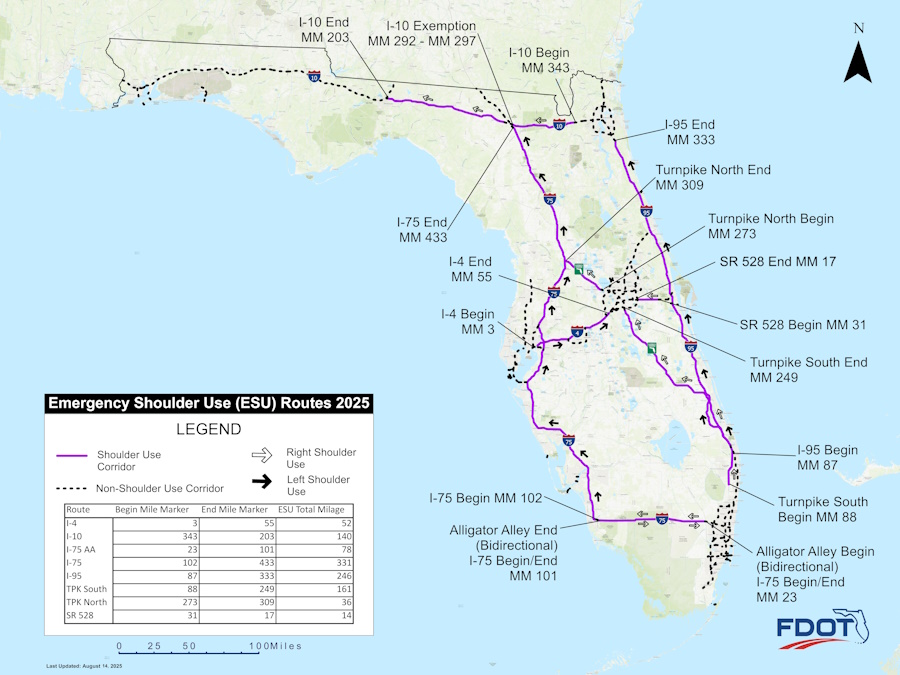Emergency Shoulder Use

Emergency Shoulder Use (ESU) is Florida's innovative strategy to temporarily increase traffic flow and capacity during major hurricane evacuations using existing paved shoulders. First developed in 2017 and covering key corridors within the state, ESU replaced the former one-way plans, also known as contraflow and lane reversal.
When ESU is operational, all motorists except large trucks, buses, and trailers may use the shoulder as a travel lane. Motorists may enter and exit the shoulder at designated locations where law enforcement officers and posted signage indicate. ESU uses the left or inside shoulder on six-lane roadways, while the right or outside shoulder is used on four-lane roadways.
When driving in the shoulder — which are about two feet narrower than standard lanes — motorists need to slow down, navigate carefully, and watch for gutters, inlets, and places where the shoulder narrows for obstacles such as bridges, overpasses, guardrails, and barrier walls. Motorists in the shoulder will also notice a continuous noise due to the presence of rumble strips.
ESU was first implemented for Hurricane Irma in September 2017. Evacuees were permitted to drive on the inside shoulder of Interstate 4 eastbound from Tampa to Kissimmee, and on the inside shoulder of Interstate 75 northbound from Wildwood to Georgia. ESU was next used for Hurricane Ian in September 2022. Evacuees were permitted to drive on the inside shoulder of Interstate 4 eastbound from Tampa to Celebration. ESU was most recently activated for Hurricane Milton in October 2024. Evacuees were permitted to drive on the inside shoulder of Interstate 4 northbound from Tampa to Celebration, the inside shoulder of Interstate 75 northbound from Tampa to Lake City, and the outside shoulder of Interstate 75 Alligator Alley southbound from Miles City to Andytown.
ESU Routes
ESU routes, concept plans, and standard operating procedures are reviewed annually. Last updated in 2025, there are currently ESU plans for nine segments on seven roadways.
- Interstate 4
- Eastbound from US 41 in Tampa (Hillsborough) to US 27 in Davenport (Polk)
- Interstate 10
- Westbound from US 301 in Jacksonville (Duval) to US 319 in Tallahassee (Leon)
- Interstate 75
- Northbound from SR 951 in Naples (Collier) to Interstate 10 in Lake City (Columbia)
- Interstate 75 Alligator Alley
- Northbound from US 27 in Weston (Broward) to SR 951 in Naples (Collier)
- Southbound from SR 951 in Naples (Collier) to US 27 in Weston (Broward)
- Interstate 95
- Northbound from SR 706 in Jupiter (Palm Beach) to SR 9B in Jacksonville (Duval)
- Florida's Turnpike
- Northbound from Hypoluxo Road in Boynton Beach (Palm Beach) to Osceola Parkway in Kissimmee (Osceola)
- Northbound from SR 50 in Winter Garden (Orange) to US 301 or SR 44 in Wildwood (Sumter)
- State Road 528
- Westbound from SR 520 near Tosohatchee (Orange) to Beachline Mainline Plaza in Orlando (Orange)

ESU Benefits
ESU has many benefits, especially when compared to one-way operations.
- ESU provides additional capacity and improves traffic flow.
- ESU may be used all day and night, while one-way operations are restricted to daytime only.
- Far fewer resources such as cones, signs, barriers, law enforcement officers, and FDOT personnel are required to implement ESU.
- Shorter notice is required for implementation and deactivation of ESU.
- Flexibility exists to implement ESU modularly by corridor or section as needed.
- ESU does not impact the opposing traffic flow, such as first responders travelling toward an incident.
- Arterial and local roadways are not disrupted during ESU operations.
ESU Videos
You can learn more about ESU and how it works by watching our public information videos.
- ESU Video 1 (4:56) 388 MB
- ESU Video 2 (3:09) 467 MB
- ESU PSA 1 (0:30) 21 MB
- ESU PSA 2 (0:58) 38 MB
Additional Resources
- Get real-time traffic information from FL511.com.
- Obtain official forecasts from the National Hurricane Center and your local weather forecast office.
- Become weather aware and prepare for all types of severe weather.
- Learn about your area evacuation routes and shelters.
- Determine if you are in a designated evacuation zone.
- Build a family or business preparedness plan before a disaster strikes.
- Contact your county emergency management office for local guidance and resources.

